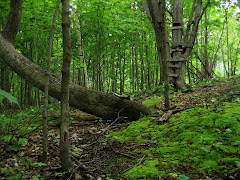I am listening (during this lovely commute) to Bill Bryson's A Short History of Nearly Everything (I heard the first chapter
 in January) and am learning a lot of terribly useful information. I now know (but may not remember next week) that there are subatomic particles called wimps and machos - neither of which may actually exist. There is a large crater impact in Manson, IA. Australia is sinking. You should not run around Yellowstone Park in the dark without a flashlight. Mount St. Helen erupted from its side. The catastrophic destruction of the earth is 'overdue' on several fronts (or faults, supervolcanos, or meteors showers). In the twinkling of an eye a landslide carried away the tent of the parents of a family, leaving the children sleeping and unhurt. Every year 30 000 metric tons of space dust land on earth. Scientists are now more certain about the age of the earth (~4.5 billion years) than they are about what causes gravity. (although there is ample evidence of its existence). It seems reasonable to assume however that in 4.5 billion years from now - we won't be here.
in January) and am learning a lot of terribly useful information. I now know (but may not remember next week) that there are subatomic particles called wimps and machos - neither of which may actually exist. There is a large crater impact in Manson, IA. Australia is sinking. You should not run around Yellowstone Park in the dark without a flashlight. Mount St. Helen erupted from its side. The catastrophic destruction of the earth is 'overdue' on several fronts (or faults, supervolcanos, or meteors showers). In the twinkling of an eye a landslide carried away the tent of the parents of a family, leaving the children sleeping and unhurt. Every year 30 000 metric tons of space dust land on earth. Scientists are now more certain about the age of the earth (~4.5 billion years) than they are about what causes gravity. (although there is ample evidence of its existence). It seems reasonable to assume however that in 4.5 billion years from now - we won't be here.The more I examine the universe and study the details of its architecture, the more evidence I find that the universe is some sense must have known we were coming. --Freeman Dyson

